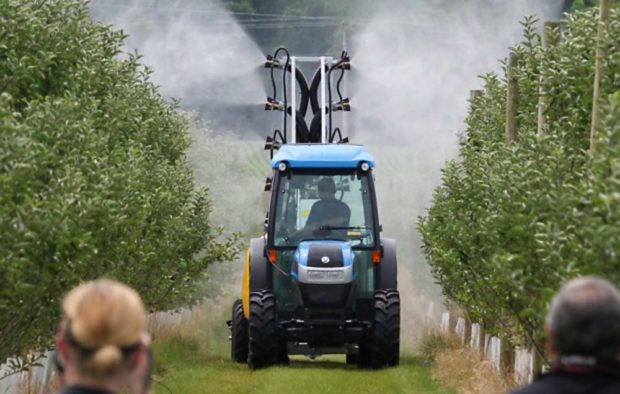
Today’s high-density apple systems create a very different canopy than older, freestanding trees, but for growers in Ontario who are managing both, a one-size-fits-all spray approach just doesn’t fit anymore.
Ontario Ministry of Agriculture, Food and Rural Affair’s “spray guy,” Jason Deveau, demonstrated how easy it is to overapply product in narrow canopy, for attendees at the International Fruit Tree Association’s summer tour in Ontario.
He used water-sensitive paper to assess the coverage of a Hol Spraying System CF airblast sprayer for high and low rates, an approach he recommends to growers as they calibrate their equipment for different blocks and canopy density throughout the season.
The first spray drenched the paper. The low pass left a speckled pattern – that’s all you need for foliar products such as pesticides, Deveau said.
“Is there any chance a mobile insect can get between these dots?” he asked, holding the paper up to the gathered crowd. Nope. “Every drop that hits is just as hot, you just go further with the tank.”
The demo took place at Hedges’ Apples, in the Norfolk region. Grower Chris Hedges farms 250 acres, including new plantings of 2.5 feet by 11 feet and blocks of big old trees he’s spent several years pruning back into manageable architecture.
“I would not buy an existing orchard again,” he said, citing the work and cost involved in trying to transition older blocks into a management system that works for himself and his staff.
In a fourth-leaf block of Honeycrisp planted on Geneva 41 roots, Hedges shared his efforts to manage the vigorous trees and took questions and advice from tour attendees. Despite aggressive pruning and hedging, “these trees have grown like crazy since the day they were planted,” he said, adding that he’d probably go back to planting on less vigorous Budovosky 9 roots in the future.
Next, the 140 or so tour attendees had the chance to see a crop few had any experience of: ginseng. The difficult-to-grow tuber performs well in the sandy soils of the Norfolk region, and Canadian growers harvest about 10 million pounds every year, according to grower Jim Lucas.
The challenge is that the crop, which takes about 5 years to produce from soil prep to harvest, can only be grown once on a given site. With business booming in recent years, growers are running out of high-quality land to expand, Lucas said.
Ginseng production benefits other growers in the region when the land is ready to be replanted with something else, Hedges added, because farmers such as Lucas do very intensive nutrition and weed control plans to produce high-value ginseng.
After a stop at the Norfolk Cherry Company, where the two-week tart cherry packing season was in full swing, Lingwood Farms hosted the final stop. Co-owner Murray Porteous introduced a third-leaf Gala and Ambrosia block, planted in the Tall Spindle Tip system developed at Wafler Farms in New York.
The rows alternate 8-feet and 13-feet spacings, leaning about 16 inches, and platforms can easily pick the tops from the wider rows, Porteous said. He decided to try this system because it allowed for higher density but also offered that space for picking with his existing equipment, and so far, he likes it.
“We had a tornado go through this last year and we didn’t lose a tree,” he said.
Stay tuned for more Good Fruit Grower coverage from the tour over the next few days. On Twitter? Follow editor Kate Prengaman @kprengaman and photographer TJ Mullinax @findtj for real-time highlights from Ontario.
—by Kate Prengaman






Leave A Comment